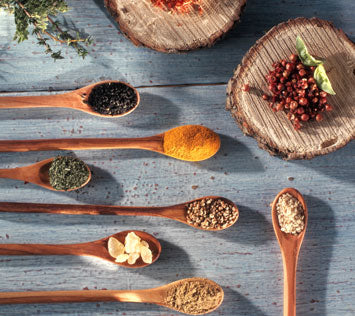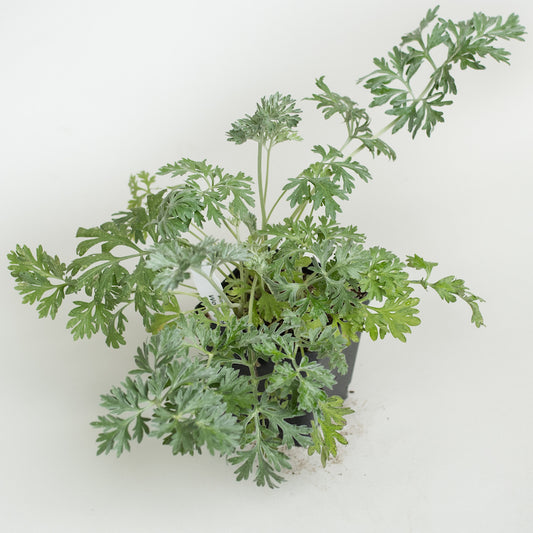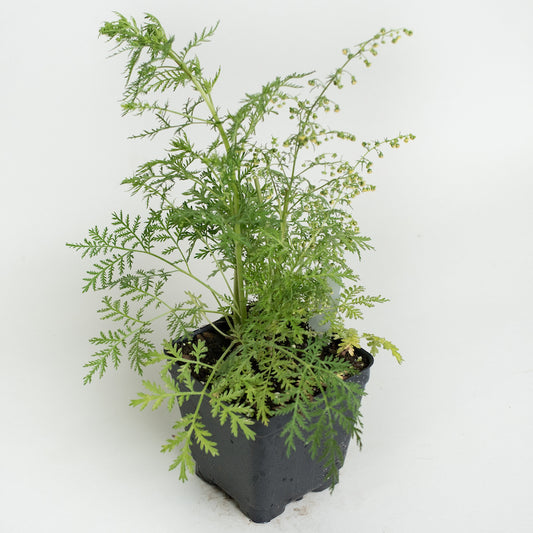Add a touch of sophistication to your botanical haven. Artemisia plants, also known as wormwoods or mugworts, are coveted for their distinctive silvery-gray foliage and aromatic scent. Each Artemisia plant brings undeniable charm and character to any landscape or garden.
The Growers Exchange features a selection of Artemisia plants for sale that are perfect for creating striking borders and accents. These plants are prized for their ornamental beauty and renowned for their natural insect repellent and ancient medicinal properties.
What Are the Benefits of Growing Artemisia at Home?
Having your own Artemisia plant can provide several benefits. Some key Artemisia plant benefits include:
-
Medicinal Properties: Some species of Artemisia, such as our Artemisia annua, have been traditionally used for natural medicine. These include their anti-inflammatory, anti-microbial, and anti-parasitic properties. It is also a source of artemisinin, an important compound for treating malaria.
-
Pest Control: Artemisia plants have a strong scent and contain natural insect-repellent compounds. Growing the plant near other susceptible plants can help deter pests like aphids, whiteflies, and cabbage moths.
-
Ornamental Value: Many Artemisia species are prized for their attractive, silvery-gray foliage. These plants can bring beauty and contrast to your home garden, especially when paired with plants with dark or bright-colored leaves.
-
Drought Tolerance: Most Artemisia species are drought-tolerant, which makes them suitable for growing in areas with water limitations or in xeriscaping. An Artemisia plant can grow well on slopes or hillsides, helping to stabilize the soil and prevent erosion.
-
Low Maintenance: Artemisia plants are generally hardy and require minimal care, making them suitable for busy homeowners or beginner gardeners. You can also grow an Artemisia plant indoors if you don't have outdoor space available.
What Are the Differences Between Artemisia Wormwood and Sweet Annie Variants?
Artemisia 'Powis Castle,' or wormwood, is a hybrid species made from a cross between Artemisia arborescent and Artemisia absinthium. It is a perennial, semi-evergreen shrub known for its silver-gray foliage.
This plant is commonly grown for ornamental purposes in gardens due to its attractive foliage, aromatic scent, and ability to blend well with other plants. 'Powis Castle' is drought-tolerant and can withstand poor soils and sunny conditions. However, it has no known medicinal uses, making it a suitable choice for purely aesthetic purposes.
Artemisia annua, or sweet wormwood or sweet annie, is a species native to Asia, mainly in China. It is an annual herbaceous plant that can grow up to two meters tall. The plant has small, green, aromatic leaves and yellow or pale green flowers.
This Artemisia plant prefers well-drained soil and sunny conditions. It is well-known for its medicinal properties, particularly the compound artemisinin, which is extracted from its leaves. Artemisinin is an important antimalarial drug used to fight malaria. The plant also has traditional uses in Chinese medicine.
How To Take Care of Your Artemisia Plant
We ship your Artemisia plant in good health and at the perfect time for you to transplant it into your garden or indoor pot. No matter what Artemisia species you have, here are some general guidelines for caring for your Artemisia plant.
-
Transplanting: Space Artemisia plants according to their mature size. Generally, this means about 18 to 36 inches apart. Plant them at the same depth they were in their pots, and water the soil well after planting.
-
Light: Most Artemisia plants thrive in full sun. Choose a spot in your garden or yard that provides at least 6 to 8 hours of direct sunlight daily. Some species, like mugwort, can tolerate partial shade but will grow better when exposed to plenty of light.
-
Water: Water your Artemisia plant moderately, allowing the soil to dry slightly between waterings. Over-watering can cause root rot and will weaken the plant. They are fairly drought-tolerant once established, but young plants and those in containers still require regular watering.
-
Soil: Artemisia plants prefer well-draining, light, and slightly alkaline soil. Mixing in some sand or fine gravel can improve drainage. Avoid planting your Artemisia in heavy soils that tend to become waterlogged.
-
Fertilizer: Artemisia plants usually don't require much fertilization. However, you can provide a balanced, slow-release fertilizer in spring to encourage healthy growth. To suppress weeds and maintain soil moisture, apply a 2-inch layer of organic mulch around the base of the plant. Keep the mulch a few inches away from the stem to prevent rot and fungus.
How To Prune and Propagate Your Artemisia
Prune your Artemisia plant in early spring to maintain its shape and encourage bushy growth. Remove dead, damaged, or older woody stems. For most species, don't prune more than one-third of the plant's height.
The easiest way to propagate Artemisia is through softwood cuttings in spring or early summer. Alternatively, some species can be propagated by dividing the clumps or collecting and sowing their seeds.
Find New Additions to Your Garden at The Growers Exchange
Achieve a stunning garden with healthy, new additions from The Growers Exchange! Browse our vast catalog of herbs and other plants to find ornamental, culinary, and other plants that meet your style.




